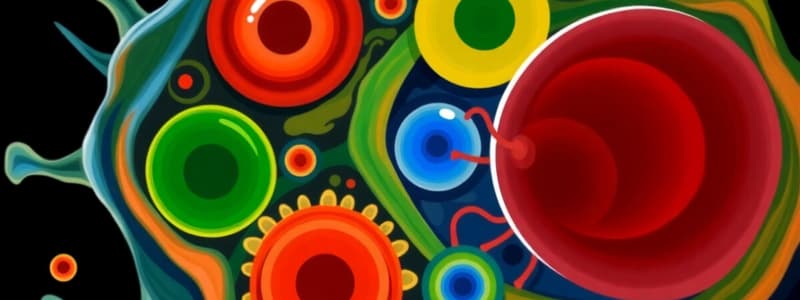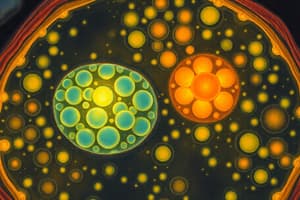Podcast
Questions and Answers
What do mitochondria provide for protein synthesis?
What do mitochondria provide for protein synthesis?
- amino acids for protein synthesis
- oxygen for respiration
- ATP for protein synthesis (correct)
- carbon dioxide for the production of sugars
In single-celled organisms, materials are primarily stored in which structure?
In single-celled organisms, materials are primarily stored in which structure?
- vacuoles (correct)
- ribosomes
- nuclei
- mitochondria
Which structure is responsible for the synthesis of ATP?
Which structure is responsible for the synthesis of ATP?
- Structure A
- Structure D
- Structure B
- Structure C (correct)
Which structure allows the passage of materials into and out of the cell?
Which structure allows the passage of materials into and out of the cell?
Which structure is responsible for excreting most cellular wastes?
Which structure is responsible for excreting most cellular wastes?
What contains the largest amount of DNA in a plant cell?
What contains the largest amount of DNA in a plant cell?
In a cell, where must information that controls protein production pass from the nucleus?
In a cell, where must information that controls protein production pass from the nucleus?
What term describes a structure that performs a specialized function within a cell?
What term describes a structure that performs a specialized function within a cell?
What structure is primarily responsible for the identification of a plant cell?
What structure is primarily responsible for the identification of a plant cell?
Which organelle is primarily associated with the synthesis of long chains of amino acids?
Which organelle is primarily associated with the synthesis of long chains of amino acids?
Which structure functions as a storage site for organic acid wastes in a cell?
Which structure functions as a storage site for organic acid wastes in a cell?
Which option best represents the sequence of biological organization from simplest to most complex?
Which option best represents the sequence of biological organization from simplest to most complex?
Which term describes a group of similar cells that function together?
Which term describes a group of similar cells that function together?
Which of the following processes is primarily associated with mitochondria?
Which of the following processes is primarily associated with mitochondria?
Which of these options accurately describes structures found in every living cell?
Which of these options accurately describes structures found in every living cell?
What cellular structure is represented by the circle labeled X in a diagram showing human body cells?
What cellular structure is represented by the circle labeled X in a diagram showing human body cells?
Which of the following is a defining characteristic of mitochondria?
Which of the following is a defining characteristic of mitochondria?
Which letter in a diagram of a plant cell would indicate the structure responsible for excretion?
Which letter in a diagram of a plant cell would indicate the structure responsible for excretion?
Which structures can be found in a typical plant cell?
Which structures can be found in a typical plant cell?
In humans, which level of organization comes after 'cells'?
In humans, which level of organization comes after 'cells'?
Which of the following sequences represents a decrease in complexity?
Which of the following sequences represents a decrease in complexity?
What is the primary function of organelle X identified in the diagram?
What is the primary function of organelle X identified in the diagram?
Which two raw materials are typically required for the process performed by organelle X?
Which two raw materials are typically required for the process performed by organelle X?
What is one important molecule produced by organelle X and its significance?
What is one important molecule produced by organelle X and its significance?
Which cell structure interacts with organelle X to help maintain homeostasis?
Which cell structure interacts with organelle X to help maintain homeostasis?
In order from least complex to most complex, which of these is correct?
In order from least complex to most complex, which of these is correct?
What is a common characteristic of humans and many other multicellular animals?
What is a common characteristic of humans and many other multicellular animals?
Which sequence correctly represents the order of organization in complex organisms?
Which sequence correctly represents the order of organization in complex organisms?
Where in the cell are proteins synthesized?
Where in the cell are proteins synthesized?
Why might a heart muscle cell contain more mitochondria than a skin cell?
Why might a heart muscle cell contain more mitochondria than a skin cell?
What is the primary function of the organelle that produces proteins?
What is the primary function of the organelle that produces proteins?
What process is associated with mitochondria, which is critical for cellular function?
What process is associated with mitochondria, which is critical for cellular function?
Which cell structure helps maintain homeostasis?
Which cell structure helps maintain homeostasis?
Which component is typically not found in animal cells but is present in plant cells?
Which component is typically not found in animal cells but is present in plant cells?
Flashcards are hidden until you start studying
Study Notes
Cell Structure and Function
- Cell membrane (Structure 4): Provides rigid support for the cell.
- Mitochondria: Produce ATP (adenosine triphosphate) for protein synthesis.
- Ribosomes: Synthesize proteins.
- Vacuoles: Store materials in single-celled organisms.
- Digestive enzymes: Synthesized in structure 3 of a cell.
- ATP synthesis: Occurs in structure A of a cell.
- Passage of materials into and out of the cell: Occurs through structure C of a cell.
- Oxygen production: Occurs in structure D of a cell.
- Excretion of cellular wastes: Occurs through structure C of a cell.
- DNA storage: Primarily contained in the nucleus of a plant cell.
- Information transfer for protein production: Passes from the nucleus to ribosomes.
- Excretion: Associated with structure A of a cell.
- Organelle: A structure that performs a specialized function within a cell.
- Protein synthesis: Primarily occurs in structure B of a cell.
- Plant cell storage of organic acid wastes: Occurs in structure B of a cell.
- Metabolic process associated with the organelle: Aerobic respiration.
- Structures found in every living cell: A plasma membrane and cytoplasm.
- Plant cell identification: The presence of a cell wall (structure E) and chloroplasts (structure F) differentiates a plant cell from an animal cell.
- Levels of organization in humans: Levels of organization increase in complexity from molecules to organelles, tissues, organs, and organ systems.
- Groups of cells with similar function: Form tissues.
- Sequence of increasing complexity: Organelles, cells, tissues, organs, organism.
- Similarity between humans and multicellular animals: Both are composed of organ systems.
- Order of organization in complex organisms: Cells, tissues, organs, systems.
- Protein synthesis location: Proteins are synthesized in ribosomes.
- Mitochondrial diseases: Cause fatigue and weakness as mitochondria are responsible for ATP production, which is essential for energy.
- Mitochondria in heart muscle cells: Heart muscle cells contain a higher proportion of mitochondria than skin cells because they require more energy to contract.
- Organelle function: The organelle in the diagram represents a chloroplast, where photosynthesis takes place. This process converts light energy into chemical energy (glucose), which is essential for survival.
- Plant cell structure not found in animal cells: A cell wall.
- Cell structure's role in homeostasis: Structure 1 (cell membrane) regulates the passage of substances into and out of the cell, maintaining a stable internal environment. It is associated with the movement of water and dissolved substances. The cell membrane interacts with structure 3 (cytoplasm) to maintain homeostasis.
- Organelle X function: Organelle X represents a chloroplast, where photosynthesis takes place. It converts light energy, water, and carbon dioxide into glucose and oxygen. Glucose is the energy source for the organism, while oxygen is released into the atmosphere.
- Order of complexity from least to most complex: Cell, organelle, tissue, organ, organism.
- Process carried out in cell Y but not in cell X: Photosynthesis.
- Function of lettered parts in the diagram: The specific letter must be chosen for this response to provide a complete answer.
Studying That Suits You
Use AI to generate personalized quizzes and flashcards to suit your learning preferences.




